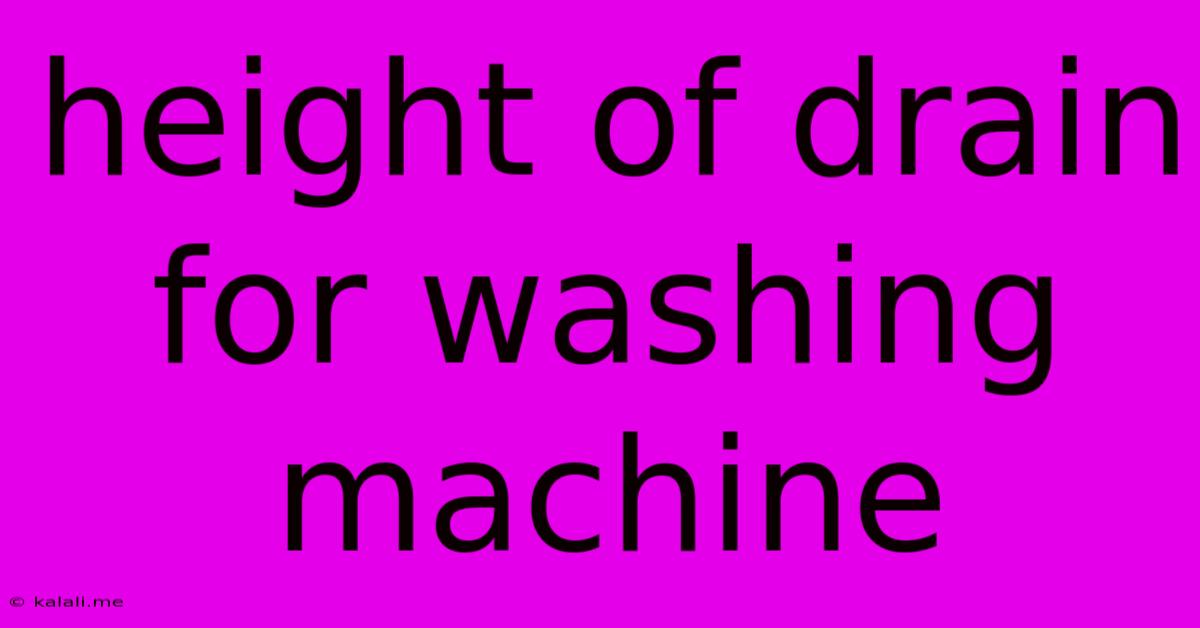Height Of Drain For Washing Machine
Kalali
Jun 07, 2025 · 3 min read

Table of Contents
Finding the Perfect Height for Your Washing Machine Drain: A Comprehensive Guide
Meta Description: Learn the ideal drain height for your washing machine to prevent overflows and ensure efficient operation. This guide covers different washing machine types, plumbing considerations, and troubleshooting tips.
Installing a washing machine might seem straightforward, but getting the drain height right is crucial for preventing overflows and ensuring your appliance functions optimally. A poorly placed drain can lead to numerous problems, from frustrating leaks to costly repairs. This comprehensive guide will walk you through determining the correct height for your washing machine drain, covering various scenarios and troubleshooting common issues.
Understanding Washing Machine Drain Requirements
The ideal drain height for a washing machine depends primarily on the type of machine you own and the specific manufacturer's recommendations. While there's no single universal height, most manufacturers suggest a range between 63 and 96 inches (160-244 cm) above the floor. This range allows for proper drainage, even when dealing with potential clogs or slow drainage. However, always consult your washing machine's installation manual for the most accurate and specific guidance. The manual often provides detailed diagrams and specifications relevant to your model.
Factors Influencing Drain Height
Several key factors beyond manufacturer recommendations influence the optimal drain height:
-
Gravity: Gravity plays a vital role. The higher the drain, the better the water flow due to increased gravitational pull. This is especially important for high-efficiency washing machines (HE) that use less water pressure for drainage.
-
Standpipe Height: The standpipe is the vertical pipe extending from your drain line. The drain hose needs to reach the standpipe comfortably to prevent siphoning. Insufficient standpipe height can lead to backflow of wastewater into the washing machine.
-
Drain Hose Length: The length of your washing machine drain hose directly impacts the placement of the drain. A longer hose provides more flexibility in positioning, but excessive length can increase the risk of kinking or trapping air, hindering drainage.
-
Washing Machine Location: The location of your washing machine dictates the practical limitations of the drain height. You might need to adjust your placement based on existing plumbing and available space.
-
Plumbing Configuration: Existing plumbing fixtures and the overall layout of your laundry area will influence the feasibility of different drain heights. You may need professional assistance if modifications are required.
Troubleshooting Common Drain Issues
Even with a correctly positioned drain, problems can occur. Here's how to address common issues:
-
Slow Drainage: This could be due to a clogged drain line, a kinked drain hose, or insufficient standpipe height. Inspect your drain hose for kinks and use a drain snake or plumber's auger to clear any clogs.
-
Overflow: An overflowing washing machine is a serious problem. Check the drain height again, ensure the drain hose is properly secured to the standpipe, and investigate potential clogs in the drain line.
-
Backflow: Backflow occurs when wastewater flows back into the washing machine. This usually indicates insufficient standpipe height or a poorly secured drain hose. Verify the standpipe height meets manufacturer recommendations.
Best Practices for Washing Machine Drain Installation
-
Professional Installation: If you're unsure about any aspect of washing machine drain installation, consult a qualified plumber. They can assess your plumbing setup and ensure the installation meets all safety and code requirements.
-
Secure Connections: Ensure all connections are secure and watertight to prevent leaks. Regularly check for leaks, especially during the initial weeks after installation.
Following these guidelines and understanding the factors that influence drain height will help you ensure your washing machine operates smoothly and efficiently. Remember, always prioritize safety and consult your washing machine's manual for specific instructions related to your model.
Latest Posts
Latest Posts
-
How To Get Cat To Stop Scratching Door
Jun 07, 2025
-
Fluent Ftp Can We Use To Call Thrid Party Api
Jun 07, 2025
-
How Does Toshinori Lose One For All
Jun 07, 2025
-
Scp Folder From Remote To Local
Jun 07, 2025
-
Should I Play Hz In Sine
Jun 07, 2025
Related Post
Thank you for visiting our website which covers about Height Of Drain For Washing Machine . We hope the information provided has been useful to you. Feel free to contact us if you have any questions or need further assistance. See you next time and don't miss to bookmark.